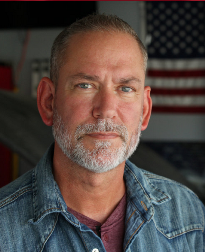Will Dan Osborn Notch a Nebraska US Senate Electoral Record?
George Norris set a high bar for independent and third party U.S. Senate candidacies in a state that otherwise has a paltry record for non-major party candidates for the office

But a recent SurveyUSA poll of 1,293 registered voters found Republican U.S. Senator Deb Fischer statistically tied with independent mechanic and former national guardsman and union president Dan Osborn (39 to 38 percent respectively with 23 percent undecided).
The 2024 race for the Class I seat (a special election for the Class II seat is also on the ballot) marks the first time Nebraska will not have a Democratic candidate (and two major party nominees) in a U.S. Senate race in the direct election era.
As a result, Osborn has a chance to record the largest support in state history for an independent or third party U.S. Senate candidate.
To date, that distinction belongs to former progressive Republican U.S. Senator George Norris.
Norris was a sitting four-term incumbent in 1936 when he left the GOP and filed to run as an independent. Norris won the general election with a plurality 43.8 percent – defeating former five-term Republican U.S. Representative Robert Simmons by 5.0 points and former one-term Democratic U.S. Representative Terry Carpenter by 25.5 points.
Norris served the entirety of his fifth term as an independent, but fell short as an independent in his bid for a sixth term when Republican Pawnee City Mayor and former State Senator Kenneth Wherry unseated him by 20.3 points.
Norris received 28.6 percent and placed a distant second that race – the second best showing by a non-major party U.S. Senate candidate in Nebraska history.
In fact, no other independent or third party candidate has received double-digit support in a race for the office in state history and only two candidates have exceeded five percent.
In 2020, independent-Democrat Preston Love (who is the Democratic nominee in 2024’s special) received 6.3 percent of the vote as a write-in candidate.
In that same race, Libertarian nominee Gene Siadek set a state party record for the office with 5.9 percent.
Only five other non-major party Nebraska U.S. Senate candidates have received more than three percent of the vote:
- 1922: Independent James Beebe, a reverend from Omaha and chair of the Progressive Party Executive Committee, won 4.9 percent
- 1930: Independent Beatrice Craig, a Lincoln teacher and education leader, withdrew from the GOP primary earlier that cycle and won 3.4 percent
- 1952: Independent Dwight Dell, a farmer from Rockford Township, won 3.1 percent
- 1982: Independent Virginia Walsh, a lobbyist from Omaha for the Nebraska Coalition for Women, won 4.9 percent
- 2018: Libertarian Jim Schultz of Lincoln won 3.6 percent
From 1916 through 2022, there have been only a total of 22 independent or third party U.S. Senate candidates on the 40 Nebraska U.S. Senate general and special election ballots.
Follow Smart Politics on X/Twitter.

Hm…have we not seen this movie before – most recently in UT 2022 and KS 2014?
If this survey (and perhaps some others) turns out to have accurately predicted the result then an *appointed* incumbent will retain his seat by a higher share/wider margin than an elected incumbent will hers on the same ‘double-barrel’ ballot.
One would expect the likelihood is greater than not that the cycle will play out similar to those elections you mention. Though, even if Fischer wins by 10 points, in a two-candidate field Osborn would still technically receive more support (45 percent) than any other non-major party U.S. Senate candidate in state history.
Eric, happy 18th anniversary of smart politics, I guess this means it’s a senior in high school set to graduate in May 2025, hehehe. I mentioned in a past article that I 1st found this site in 2017, you glued me to the site with your interesting historical facts about varies topics and now I constantly float between your site, center for politics and 270 to win every day.
https://centerforpolitics.org/crystalball/
https://www.270towin.com/
I know I sound like a broken record but, I’ll keep saying this for the next 2 months as much as I can: Get all of your family, friends, neighbors, co-workers and anybody else that y’all can reach out to VOTE like your lives depend on it.
Thank you very much, Connor! It did escape my memory that my first post at Smart Politics was on a September 5th all those years ago. I genuinely appreciate your continued interest and contributions/comments!
George William Norris “set a high bar” for other statewide political candidates of the Cornhusker State as well; only “Jim” Exon has been elected *five* times to a statewide partisan office in state history (by either direct popular vote or indirect state legislative vote).
{Broader Senate landscape} Interestingly, while Peach and Tar Heel states are considered “battleground” venues neither has a US Senate election. By contrast, the Old Line State is not considered a contested presidential terrain, but it does have a Senate election that more than a few regard as contestable, if only due to the caliber of the Republican nominee.
With those realities in mind, which seat (neither in presidential battleground) is comparatively more likely to change from Democratic to Republican, the Buckeye State seat held by Sherrod Brown, or the Treasure State seat held by Jon Tester?
[…] Osborn overtook former progressive Republican U.S. Senator George Norris’s nearly 90-year old state recor… along the […]